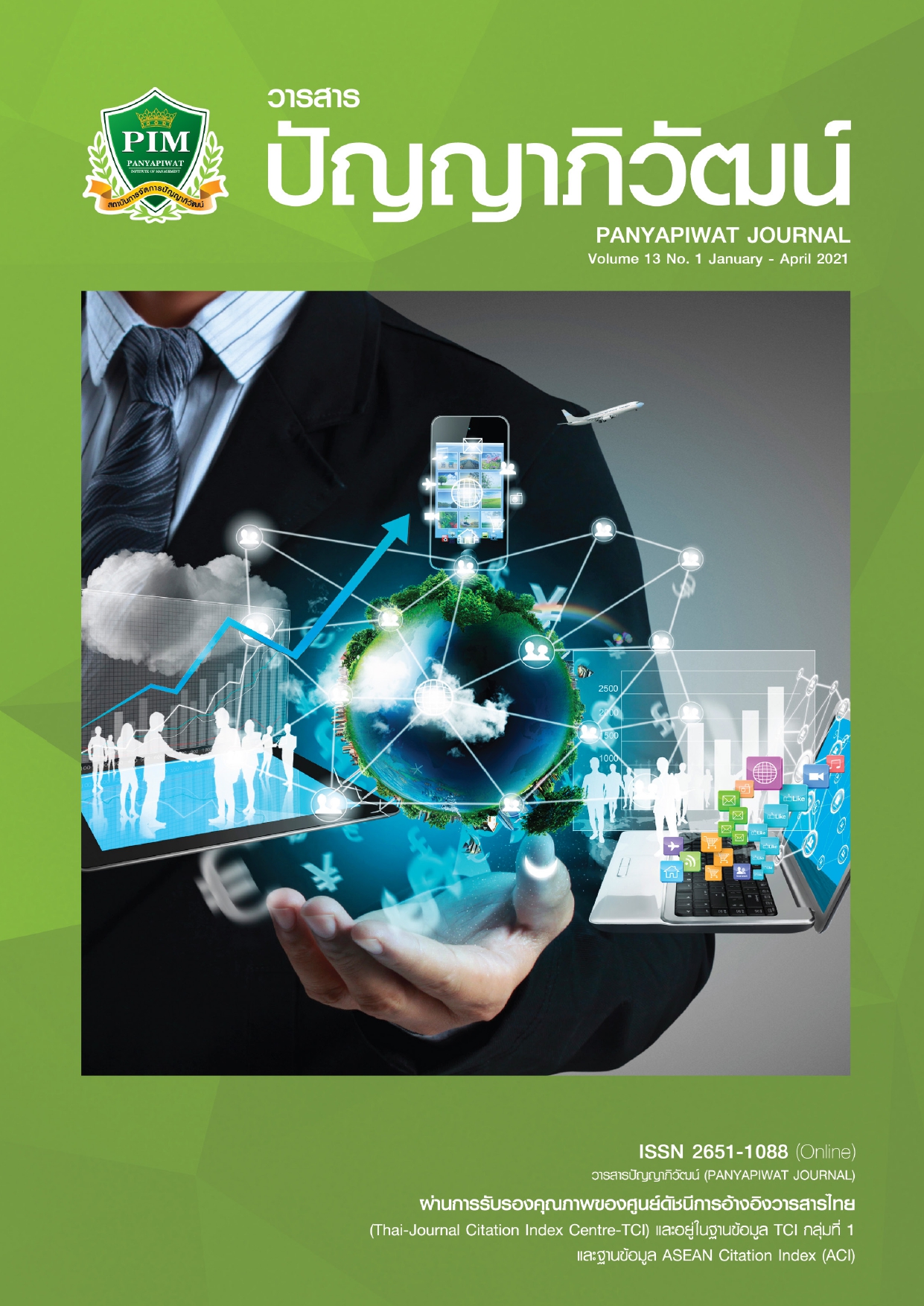ความไว้วางใจ ความเสี่ยงและประโยชน์ในการแบ่งปันข้อมูลอย่างต่อเนื่อง ผ่านเครือข่ายสังคมออนไลน์
Main Article Content
บทคัดย่อ
การศึกษานี้มีวัตถุประสงค์เพื่อศึกษาองค์ประกอบและอิทธิพลของความไว้วางใจ ปัจจัยการรับรู้ประโยชน์ และการรับรู้ความเสี่ยงในการแบ่งปันข้อมูลบนเครือข่ายสังคมออนไลน์อย่างต่อเนื่อง การศึกษานี้ใช้วิธีการวิจัย เชิงปริมาณและแบบสอบถามออนไลน์ในการเก็บข้อมูลจากผู้ที่เคยแบ่งปันข้อมูลผ่านเครือข่ายสังคมออนไลน์ เช่น เฟซบุ๊ก ไลน์ และทวิตเตอร์ การวิเคราะห์ปัจจัยเชิงสำรวจจากผู้ตอบแบบสอบถาม 296 ราย จากจำนวน 450 ตัวอย่าง พบว่า ปัจจัยที่ทำให้มีการแบ่งปันข้อมูลผ่านเครือข่ายสังคมออนไลน์ ประกอบด้วย ความไว้วางใจ ปัจจัยการรับรู้ประโยชน์ด้านการใช้งาน ด้านความสนุกสนาน ความเสี่ยงด้านกฎหมาย ความเสี่ยงด้านความ ปลอดภัยและความเป็นส่วนตัว ปัจจัยการรับรู้ประโยชน์ด้านการใช้งาน ด้านความสนุกสนาน และความไว้วางใจส่ง ผลเชิงบวกต่อความตั้งใจในการแบ่งปันข้อมูลของผู้ใช้เครือข่ายสังคม การรับรู้ความเสี่ยงด้านกฎหมายส่งผลเชิงลบ ในขณะที่การรับรู้ความเสี่ยงด้านความปลอดภัยและความเป็นส่วนตัวไม่ส่งผลอย่างมีนัยสำคัญต่อความตั้งใจใน การแบ่งปันข้อมูลอย่างต่อเนื่อง ผลการศึกษาทำให้ทราบถึงปัจจัยที่ส่งผลการแบ่งปันข้อมูลผ่านเครือข่ายสังคม ออนไลน์อย่างต่อเนื่องที่ช่วยในการพัฒนาการตลาดดิจิทัลและข้อพึงระวัง
Article Details
“ข้าพเจ้าและผู้เขียนร่วม (ถ้ามี) ขอรับรองว่า บทความที่เสนอมานี้ยังไม่เคยได้รับการตีพิมพ์และไม่ได้อยู่ระหว่างกระบวนการพิจารณาลงตีพิมพ์ในวารสารหรือแหล่งเผยแพร่อื่นใด ข้าพเจ้าและผู้เขียนร่วมยอมรับหลักเกณฑ์การพิจารณาต้นฉบับ ทั้งยินยอมให้กองบรรณาธิการมีสิทธิ์พิจารณาและตรวจแก้ต้นฉบับได้ตามที่เห็นสมควร พร้อมนี้ขอมอบลิขสิทธิ์บทความที่ได้รับการตีพิมพ์ให้แก่สถาบันการจัดการปัญญาภิวัฒน์หากมีการฟ้องร้องเรื่องการละเมิดลิขสิทธิ์เกี่ยวกับภาพ กราฟ ข้อความส่วนใดส่วนหนึ่งและ/หรือข้อคิดเห็นที่ปรากฏในบทความข้าพเจ้าและผู้เขียนร่วมยินยอมรับผิดชอบแต่เพียงฝ่ายเดียว”
เอกสารอ้างอิง
Alsaleh, D. A., Elliott, M. T., Fu, F. Q., & Thakur, R. (2019). Cross-cultural Differences in the Adoption of Social Media. Journal of Research in Interactive Marketing, 13(1), 119-140.
Chang, S. E., Liu, A. Y., & Lin, S. (2015). Exploring Privacy and Trust for Employee Monitoring. Industrial Management & Data Systems, 115(1), 88-106.
Chang, S. E., Liu, A. Y., & Shen, W. C. (2017). User Trust in Social Networking Services: A Comparison of Facebook and LinkedIn. Computers in Human Behavior, 69, 207-217.
Chiu, C. M., Hsu, M. H., & Wang, E. T. G. (2006). Understanding Knowledge Sharing in Virtual Communities: An Integration of Social Capital and Social Cognitive Theories. Decision Support Systems, 42, 1872-1888.
Cho, H., Chen, M., & Chung, S. (2010). Testing an Integrative Theoretical Model of Knowledge Sharing Behavior in the context of Wikipedia. Journal of the American Society for Information Science and Technology, 61(6), 1198-1212.
Davis, F. (1989). Perceived Usefulness, Perceived Ease of Use, and user Acceptance of Information Technology. MIS Quarterly, 13(3), 318-341.
Dowling, G. R. & Staelin, R. (1994). A Model of Perceived Risk and Intended Risk Handling Activity. Journal of Consumer Research, 21(1), 119-134.
Gregory, G. D., Ngo, L. V., & Karavdic, M. (2019). Developing E-Commerce Marketing Capabilities and Efficiencies for Enhanced Performance in Business-to-Business Export Ventures. Industrial Marketing Management, 78, 146-157.
Herrero, A., Martín, H. S., & Salmones, M. M. L. (2017). Explaining the Adoption of Social Networks Sites for Sharing User-generated Content: A Revision of the UTAUT2. Computers in Human Behavior, 71, 209-217.
Ho, L. Y. T., Li, W. Y., & Turban, E. (2011-2012). What Drives Social Commerce: The Role of Social Support and Relationship Quality. International Journal of Electronic Commerce, 16(2), 69-90.
Jarvenpaa, S. L., Tractinsky, N., & Vitale, M. (2000). Consumer Trust in an Internet Store. Information Technology and Management, 1, 45-71.
Kim, Y. A. & Ahmad, M. A. (2013). Trust, Distrust and Lack of Confidence of Users in Online Social Media-sharing Communities. Knowledge-Based Systems, 37, 438-450
Kim, H. W., Chan, H. C., & Gupta, S. (2007). Value-based Adoption of Mobile Internet: An Empirical Investigation. Decision Support Systems, 43, 111-126.
Kim, W., Jeong, O. R., & Lee, S. W. (2010). On Social Web sites. Information Systems, 35(2), 215-236.
Lankton, N. K. & McKnight, D. H. (2011). What does it mean to trust Facebook? Examining Technology and Interpersonal Trust Beliefs. The Data Base for Advances in Information Systems, 42(2), 32-54.
Ma, L., Lee, C. S., & Goh, D. H. L. (2014). Understanding News Sharing in Social Media: An Explanation from the Diffusion of Innovations Theory. Online Information Review, 38(5), 598-615.
McKnight, D. H. & Chervany, N. L. (2001-2002). What Trust Means in E-Commerce Customer Relationships: An Interdisciplinary Conceptual Typology. International Journal of Electronic Commerce, 6(2), 35-59.
McKnight, D. H. & Choudhury, V. (2006). Distrust and Trust in B2C E-Commerce: Do They Differ? The 8th International Conference on Electronic Commerce: The New E-Commerce: Innovations for Conquering Current Barriers, Obstacles and Limitations to Conducting Successful Business on the Internet (pp. 482-491). Fredericton, New Brunswick, Canada, ACM.
McKnight, D. H., Cummings, L. L., & Chervany, N. L. (1998). Initial Trust Formation in New Organizational Relationships. Academy of Management Review, 23(3), 472-490.
Morgan, R. M. & Hunter, S. D. (1994). The Commitment and Trust Theory in Relationship Marketing. Journal of Marketing, 58, 20-38.
Pavlou, P. (2003). Consumer Acceptance of Electronic Commerce: Integrating Trust and Risk with the Technology Acceptance Model. International Journal of Electronic Commerce, 7(3), 69-103.
Rauniar, R., Rawski, G., Yang, J., & Johnson, B. (2013). Technology Acceptance Model (TAM) and Social Media Usage: An Empirical Study on Facebook. Journal of Enterprise Information Management, 27(1), 6-30.
Rotchanakitumnuai, S. (2008). Measuring E-Government Service Value with the E-GOVSQUAL-RISK Model. Business Process Management Journal, 14(5), 724-737.
Rotchanakitumnuai, S. & Speece, M. (2003). Barriers to Internet Banking Adoption: A Qualitative Study Among Corporate Customers in Thailand. International Journal of Bank Marketing, 21(6/7), 312-323.
Rotchanakitumnuai, S. & Speece, M. (2009). Modeling Electronic Service Acceptance of an E-Securities Trading System. Industrial Management & Data Systems, 109(8), 1069-1084.
Rotchanakitumnuai, S. (2020). Factors Influencing Information Sharing in Online Social Network: The Case of Fact and Fake News. Journal of Business Administration, 43(167), 1-15.
Shang, S. S. C., Wu, Y. L., & Sie, Y. J. (2017). Generating Consumer Resonance for Purchase Intention on Social Network Sites. Computers in Human Behavior, 69, 18-28.
Stone, R. & Gronhaug, K. (1993). Perceived Risk: Further Considerations for the Marketing Discipline. European Journal of Marketing, 27, 39-50.
Sweeney, J. & Soutar, G. N. (2001). Consumer Perceived Value: The Development of a Multiple Item Scale. Journal of Retailing, 77(2), 203-220.
Turel, O., Serenko, A., & Bontis, N. (2010). User Acceptance of Hedonic Digital Artifacts: A Theory of Consumption Values Perspective. Information & Management, 47, 53-59.
We are social. (2020). Digital Thailand 2020. Retrieved August, 5 2020, from https://blog.ourgreenfish.com/%E0%B8%AA%E0%B8%96%E0%B8%B4%E0%B8%95%E0%B8%B4%E0%B8%94%E0%B8%B4%E0%B8%88%E0%B8%B4%E0%B8%97%E0%B8%B1%E0%B8%A5%E0%B8%82%E0%B8%AD%E0%B8%87%E0%B8%9B%E0%B8%A3%E0%B8%B0%E0%B9%80%E0%B8%97%E0%B8%A8%E0%B9%84%E0%B8%97%E0%B8%A2%E0%B8%88%E0%B8%B2%E0%B8%81-digital-thailand%E0%B8%9B%E0%B8%A3%E0%B8%B0%E0%B8%88%E0%B8%B3%E0%B8%9B%E0%B8%B5-2020
Zhou, T. (2011). The Impact of Privacy Concern on User Adoption of Location-based Services. Industrial Management & Data Systems, 111(2), 212-226.
Zhou, T. & Li, H. (2014). Understanding Mobile SNS Continuance Usage in China from the Perspectives of Social Influence and Privacy Concern. Computers in Human Behavior, 37(10), 283-289.


